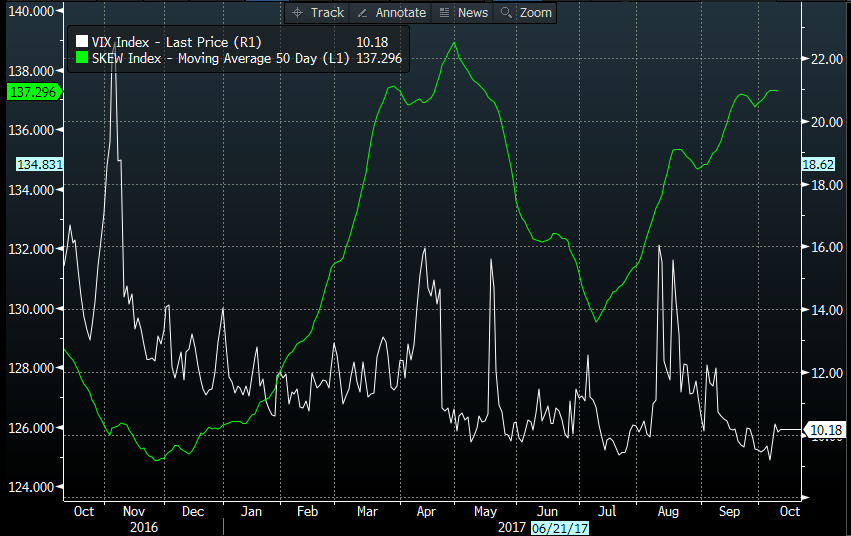There is an inherent tension in the stock market right now, on the one hand volatility remains at historically low levels, while on the other the amount of downside protection being bought is rising sharply. We question whether this hedging activity could actually be the canary in the coal mine for the US indices, and once hedging gets to an excessive level if it becomes a self-fulfilling prophecy.
The Vix vs. the CBOE Skew index
The tension in the market can be seen in clearly in the chart below. The white line is the Vix, while the green line is the 50-day moving average of the CBOE skew index for the S&P 500. While the Dow and the S&P 500 eke out further gains, this stage of the rally can be quite tumultuous for investors who don’t want to cut their trades too early and miss potential profit opportunity, but equally they don’t want to be the wrong side of a major event that causes stocks to sell off sharply.
The Skew index is derived from the price of S&P 500 tail risk, which measures the risk of outlier returns two or more standard deviations below the mean. Skew typically ranges from 100-150, with 100 suggesting returns are normal, but as the skew rises above 100 the probability of outlier returns start to increase.
As you can see in chart 1 below, the 50-day moving average of the S&P 500 skew index has been rising since July, and is currently at 137, suggesting that the chance of outlier returns has increased in recent months. So, options traders are buying out-of-the-money options in case the S&P 500 falls off a cliff, and they are doing so at an ever faster pace. In contrast, the Vix index is at extremely low levels, which is one reason why the S&P 500 is continuing to push higher and make frequent record daily closes.
Why market protection strategies could trigger a sell-off
The best way to explain this divergence is that even though traders are willing to push US indices higher, they are getting more nervous and less confident that the rally will last. The skew index rose sharply between January and May this year before pulling back between May and July. Interestingly, since the summer months, investor nervousness has once again started to rise. This rush for downside protection has coincided with the Fed shrinking its balance sheet and higher levels of political dysfunction in Washington, however, these events have not been enough on their own to trigger a sell-off.
The next few weeks may be crucial, if the CBOE skew index gets above the 139 high from May and heads towards 150 then this would suggest even more heightened levels of investor nervousness, which could trigger some large scale selling. Thus, the much-anticipated decline in the S&P 500 and other US indices may not come from a single black swan event like it did in 2008, but instead from a collective market nervousness that stems from the high levels of accumulation of downside protection against a fall in the S&P 500. Thus, at this stage of the market rally, excessive hedging may be one way of determining when the market will take a turn to the downside.
CFD’s, Options and Forex are leveraged products which can result in losses that exceed your initial deposit. These products may not be suitable for all investors and you should seek independent advice if necessary.
Recommended Content
Editors’ Picks

USD/JPY pops and drops on BoJ's expected hold
USD/JPY reverses a knee-jerk spike to 142.80 and returns to the red below 142.50 after the Bank of Japan announced on Friday that it maintained the short-term rate target in the range of 0.15%-0.25%, as widely expected. Governor Ueda's press conference is next in focus.

AUD/USD bears attack 0.6800 amid PBOC's status-quo, cautious mood
AUD/USD attacks 0.6800 in Friday's Asian trading, extending its gradual retreat after the PBOC unexpectedly left mortgage lending rates unchanged in September. A cautious market mood also adds to the weight on the Aussie. Fedspeak eyed.

Gold consolidates near record high, bullish potential seems intact
Gold price regained positive traction on Thursday and rallied back closer to the all-time peak touched the previous day in reaction to the Federal Reserve's decision to start the policy easing cycle with an oversized rate cut.

Ethereum rallies over 6% following decision to split Pectra upgrade into two phases
In its Consensus Layer Call on Thursday, Ethereum developers decided to split the upcoming Pectra upgrade into two batches. The decision follows concerns about potential risks in shipping the previously approved series of Ethereum improvement proposals.

Bank of Japan set to keep rates on hold after July’s hike shocked markets
The Bank of Japan is expected to keep its short-term interest rate target between 0.15% and 0.25% on Friday, following the conclusion of its two-day monetary policy review. The decision is set to be announced during the early Asian session.

Moneta Markets review 2024: All you need to know
VERIFIED In this review, the FXStreet team provides an independent and thorough analysis based on direct testing and real experiences with Moneta Markets – an excellent broker for novice to intermediate forex traders who want to broaden their knowledge base.
